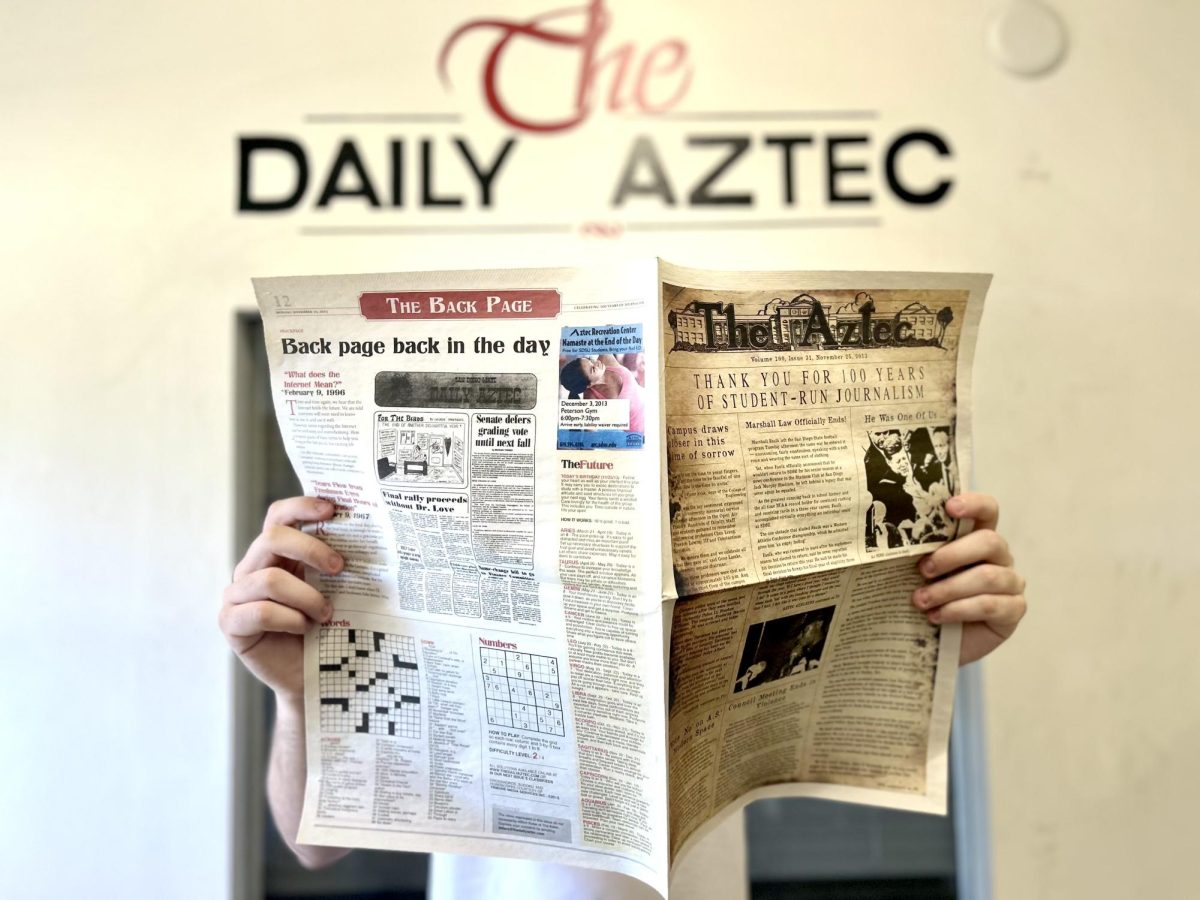The Daily Aztec turns 110 years old this month on Nov. 26, honoring the legacy of a publication that has continuously served the voice of students, faculty and staff at San Diego State University.
What makes The Daily Aztec the publication it is today surrounds the dedication of our fellow alumni. They have championed growth in the paper to provide campus news for those to stay informed.
But like the growth of most long-standing organizations, the evolution of The Daily Aztec was met with perseverance.
Before becoming The Daily Aztec, the publication was first known as Normal News Weekly after San Diego State Normal School — now recognized as SDSU — voted to publish a campus-based newspaper in the fall of 1913.
Following the vote from San Diego Normal School, Normal News Weekly would begin its first edition as a four-page tabloid on Nov. 26, 1913.
The four-page tabloid ran weekly, and often on the pages in the early volumes would say “Patronize Our Advertisers.” Back in 1913, the finances of running a newspaper were costly, especially during an unprecedented recession in the United States.
Normal News Weekly, which received financial support from advertisers, wanted to acknowledge its patrons for their expenditures in aiding the publication.
“… You voted for the establishment and maintenance of a school paper. It is now up to every one of you, individually, to meet this responsibility. You know the paper cannot subsist on San Diego climate and fricasseed air,” read the front page of Normal News Weekly. “Our advertisers pay good, hard coin for the ‘privilege’ of supporting this publication, but they, in turn, must get returns on this expenditure.”
The Normal News Weekly would then become the Paper Lantern in 1921, just three years after World War I. The Paper Lantern’s first issue was printed on Oct. 11, 1921. In its first edition, it featured university President Edward L. Hardy [1910-1935] in a story called “Heads Combined Colleges Afters Spent Here.”
Hardy, according to the Paper Lantern’s first editor, J.C. Almy Harding, “gave (The Paper Lantern) the best gifts an editor can ask (for) — a free rein both editorially and financially.”
Harding further noted that Hardy could never guarantee the publication subsidy, but he did task editors that they would be held accountable, should any “journalistic misdeeds” occur.
In 1925, the Aztec nickname was decided by students of SDSU. This decision would then reshape the entire brand of the publication, who reluctantly bowed to adopting the name, “The Aztec.”
Still maintaining a four-page weekly, The Aztec would exist approximately for 36 years, and during this time, it produced content during World War II.
In volume 21, issue 23, The Aztec delved deeper into the topic of World War II in 1941, with bolded words titled “War Hits State” on the front page.
Dorothy Lundy’s story “‘It’s Here;’ Students Become Realistic As War Blow Hits Home,” documented students coming to the harsh realization of World War II due to its impact on campus. Holding onto this global conflict, the publication also published newsletters for individuals in the armed services.
After the end of World War II, The Aztec resumed its regular publication until a milestone was reached that proposed for the paper to be published on a daily basis.
The idea — coming from the ‘59 Aztec members — initially was disapproved of by members of the Publication Authority Board, who cited there would not be enough campus support, ranging from news, student interest and finances to facilitate a functioning daily paper at San Diego State College.
However, after various conversations held, in 1960, The Aztec would finally become recognized as The Daily Aztec, and there, the paper would print its issues every day up until 1973 when another shift took place: becoming independent.
From 1925 to 1973, The Daily Aztec received financial support from advertisers, Associated Students and the university.
A.S. — which seeks to empower students and their organizations — is a student-led corporation that operates independently from the university.
The A.S. Council was responsible for approving the budget and any expenditures annually for The Daily Aztec. Members of the council also appointed the student editor (also known as editor-in-chief), but not without the approval of the university president — this procedure does not exist now.
For academics under the university, The Daily Aztec had an advisor who was involved in SDSU’s journalism department. The advisor was also a lecturer for an accredited class called “Newspaper Production.”
The structure of “Newspaper Production” consisted of Daily Aztec members — those who wanted to receive academic credit — and they would provide their carbon copies to the faculty advisor, who would in return, grade the paper after it was already delivered across campus. The advisor also provided advice to the seniors about running the paper, but it was under the staff’s discretion if they wanted to apply the feedback to their work.
Having the “Newspaper Production” course created conflicting relationships surrounding how the paper functioned. Other concerns surrounded accreditation, in which accreditors disapproved of the working relations between A.S., the journalism department and The Daily Aztec.
These tensions prompted SDSU’s fifth President, Brage Golding [1972-1977], to implement a Blue Ribbon Commission on the publication, which served as a consultant in a study.
After evaluation of the publication, the commission determined a “radical departure” and conflict of interest within The Daily Aztec: being a laboratory class under the university while also still functioning as a student paper that provided impartial campus news and editorial comment.
The Blue Ribbon Commission further suggested that the publication should have its autonomy from A.S. and the university administration, but that plan was never reached. Other conversations included plans for the publication to become a smaller paper funded by the journalism department to provide students with newspaper experience, but that idea was also never reached.
As a completion of this study, The Daily Aztec discontinued its connection with the journalism department. A year later, the idea of a campus-wide policy board, serving as a publisher for the publication, was implemented.
Decades after becoming independent, The Daily Aztec has continued to evolve (even away from print), but one mission continues to persist: “being a readily available resource of and for the SDSU community.”
In 2013, the publication — which transitioned to semi-weekly printing — launched Mundo Azteca, serving as the sister paper of The Daily Aztec. Mundo Azteca’s first online story, published on June 24, 2013, was written by Eileen Salmeron, titled “Telemundo transmite desde Tijuana.”
When the COVID-19 pandemic occurred in 2020, the campus closure impacted the newspaper. The Daily Aztec temporarily transitioned to an online-based publication and broadcasts from “Daily Aztec Live!” were pre-recorded.
From 2022 to now, the publication now publishes monthly. The reason behind the decision is to prioritize timeless articles and online content, aligning with the evolving landscape of journalism shifting toward the digital age. The diversity of this publication has also evolved from staff members to the editorial board and its editors-in-chief.
Despite all of this — overcoming hardships, finding an identity and independence — The Daily Aztec remains as a beacon of information for every individual in the SDSU community. As an award-winning paper, our journey from 110 years strives to provide an engaged and informed audience.
With devoted members, consisting of our alumni, ongoing photographers, writers, designers, advertising team and editorial board, the legacy of The Daily Aztec continues.








